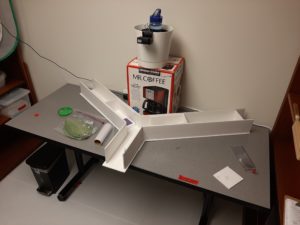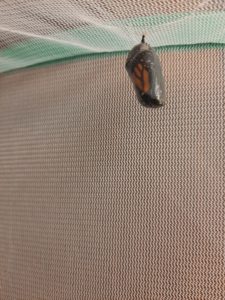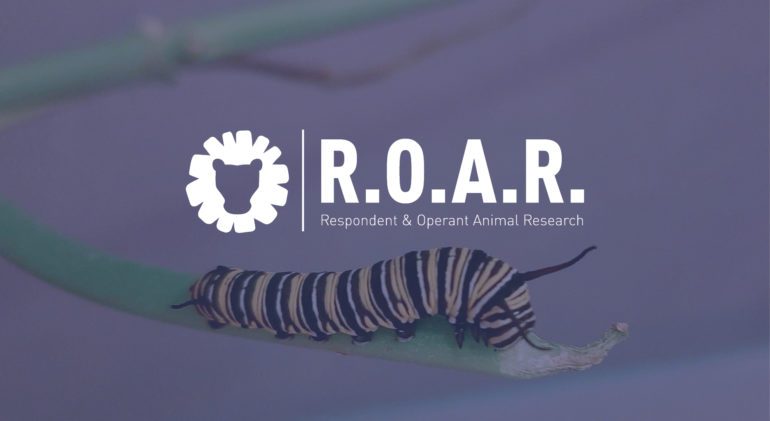Do butterflies remember being caterpillars? Will an ant risk its own life to help a wounded comrade back to the colony? And how would learning the answers to these questions potentially help humanity? Two professors at The Chicago School hope to address these puzzles and demonstrate the importance of laboratory work to their students in the Department of Applied Behavior Analysis. With the receipt of a faculty development and community partnership grant, Rocco Catrone, Ph.D. BCBA-D, and Shannon Ormandy, Ph.D. BCBA, have created the Respondent & Operant Animal Response (ROAR) research lab.
A brief history of applied behavior analysis
Behavior analysis is a discipline within the larger field of psychology that applies theories derived from studies of learned behaviors with the objective of improving behavior in a meaningful way. An important piece of behaviorism involves testing hypotheses in a controlled environment. This approach developed alongside psychoanalysis, which has been a dominant school of thought in psychology for most of the 20th century.
“I think almost everyone is familiar with that idea of the id and the ego and the super ego,” Dr. Ormandy says. “Well, those terms are just ways of conceptualizing the different causes for behavior. In a behavior analytic orientation, we’re always looking at the ultimate cause of behavior as your interaction with the environment.”
Real-world results
Both Dr. Ormandy and Dr. Catrone were drawn to ABA while working with children.
“I was introduced to behavior analysis by some peers who were working with autistic children,” Dr. Ormandy says, “and after going with one of them to observe what they were doing, I found my love and never looked back.” She received her master’s and Ph.D. at The Chicago School before joining the faculty.
Dr. Catrone’s experience was similar.
“I worked at a day school that was fantastic, and I started working with one of the behavior analysts there and really helped to support autistic children and other children that have developmental disabilities.”
A new kind of lab at The Chicago School
During a routine review with accreditors from the Association for Behavior Analysis International suggested The Chicago School’s ABA program consider adding a lab to support the applied behavior courses and to introduce students to laboratory work.
Drs. Catrone and Ormandy used the grant funds to set up in a modest room off the campus library.
The next step was to find the right subjects. Fortunately, Dr. Catrone had experience in laboratory settings and a deep appreciation for the ethical practices in the field, including conducting research with nonvertebrate and noninvasive species. While he was in graduate school at the Southern Illinois University–Carbondale, one of his professors suggested he procure a pair of Madagascar hissing cockroaches and attempt to replicate basic behavioral principles.
“At first, I thought it was stupid,” he says, “but I saw was how I could apply basic research practices.”
The advantage of indigenous test species
In contrast to a previous study conducted with an invasive moth species, Drs. Catrone and Ormandy chose caterpillars and ants indigenous to Illinois and therefore wouldn’t damage the local ecosystem when released. (Though the first monarchs they released were reluctant to leave, Dr. Ormandy remarks with a smile.)
“The ants we use are those pavement ants that you see walking anywhere in the city,” Dr. Catrone says. “If we ever need to release them, they won’t harm the ecosystem. We want to be as responsible as we can with that while also teaching that animal welfare aspect.”
Theory, meet reality
 The initial studies that showed memory retention across metamorphosis were conducted with a moth. A caterpillar was to walk across one type of surface to get a reward and to avoid another surface. After coming out of its cocoon, the moth remembered what it had been taught as a caterpillar, even though throughout the process of metamorphosis, the one-time caterpillar and future moth existed essentially as a liquid for 10 days.
The initial studies that showed memory retention across metamorphosis were conducted with a moth. A caterpillar was to walk across one type of surface to get a reward and to avoid another surface. After coming out of its cocoon, the moth remembered what it had been taught as a caterpillar, even though throughout the process of metamorphosis, the one-time caterpillar and future moth existed essentially as a liquid for 10 days.
To recreate the experiment with an ecofriendly butterfly, Dr. Catrone built a Y-maze out of foam core from Staples. “We put our little caterpillar in there,” Dr. Ormandy says, “and we wait and we wait and . . .”
“And nothing,” Dr. Catrone says.
“The caterpillar just sat there, and he didn’t go anywhere,” Dr. Ormandy says. “He explored a very, very small area around where he entered into the maze.” Rarely did the caterpillars make their way to the end point of the Y to contact the reward, the milkweed, which is the only thing they eat.
“Many times, if they did,” Dr. Catrone says, “they would crawl above the textured area that we had positioned in the Y-maze.”
The value of miscalculation
That initial experiment demonstrates a principle B. F. Skinner, an early pioneer in the field, espoused: The learner is always right. If the caterpillar was born and matured on a milkweed plant, it may never develop the capacity to seek out the plant at a genetic or behavioral level.
“If there’s never been a need in your species’ history for those responses,” Dr. Ormandy says, “then we were in error of expecting or of assuming that our learner had that skill in their repertoire—because they didn’t.”
The caterpillars taught the scientists that they needed to reconfigure the experiment.
“We sit there with philosophic doubt and success and grace and assessment and failure,” Dr. Catrone says. “That didn’t work. How do we figure it out from here?”
Additionally, the process of trial and error creates more of a peer model for students instead of a professor-knows-all model, and problem-solving becomes a collective effort as well as a learning experience.
“We are all scientists and observational humans and organisms together,” Dr. Catrone says. “How do we do this in a way that’s going to be community based and make sense? It’s been super cool to experience that.”
Advantages for students
The ROAR lab gives students a sense of what research in a highly controlled lab setting is like. The hands-on environment demonstrates the principles of the field in an immediate way that is more valuable than reading about the process.
more valuable than reading about the process.
“Often in classes that I teach, I’ll say, ‘This principle originated in a lab setting with a pigeon,’ and their eyes glaze over,” Dr. Ormandy says. It is important to demonstrate to students that behavioral analysis starts in a controlled lab. “Everything you’re doing came from here,” she adds. “This should be your home.”
Dr. Ormandy had been struggling with the question of how to get students to fall in love with the science. She had looked into the feasibility of creating a lab at the Chicago Campus of The Chicago School, but the building did not support the necessary infrastructure. When Dr. Catrone joined the faculty, she realized that they were both in love with the science, the basic research, and they wanted students to share that joy, and he had experience in creating do-it-yourself platforms. He applied that background in designing apparatuses for the ROAR lab’s butterflies and a colony of pavement ants that is currently growing in seclusion under the watchful eye of their queen, Freddie (yes, after Freddie Mercury).
Applying the science to people
The objective of ABA is to test hypotheses in a laboratory and apply lessons learned to a range of settings, from teaching skills to autistic learners to improving the efficiency of a warehouse. Every principle used clinically with humans is first demonstrated in a very highly controlled laboratory environment. In addition, any findings gleaned from studies with animals are tested and vetted through what is called “translational research” before the findings are applied to humans. This step is an important aspect of the ABA process.
The ongoing work in the ROAR lab serves as a model for the work done in the broader field of ABA. Scientists hypothesize. They devise research models and construct apparatuses with which to conduct them. The research is conducted, which tests the hypotheses as well as the assumptions of the scientists.
“Our hope is that we’ll be able to get to the point where we’re able to provide that hands-on experience with students,” Dr. Ormandy says. “If you can teach a caterpillar, think about what you can do clinically. There are no barriers to your success.”
To learn more about the Applied Behavioral Analysis program at The Chicago School, fill out the form below.

